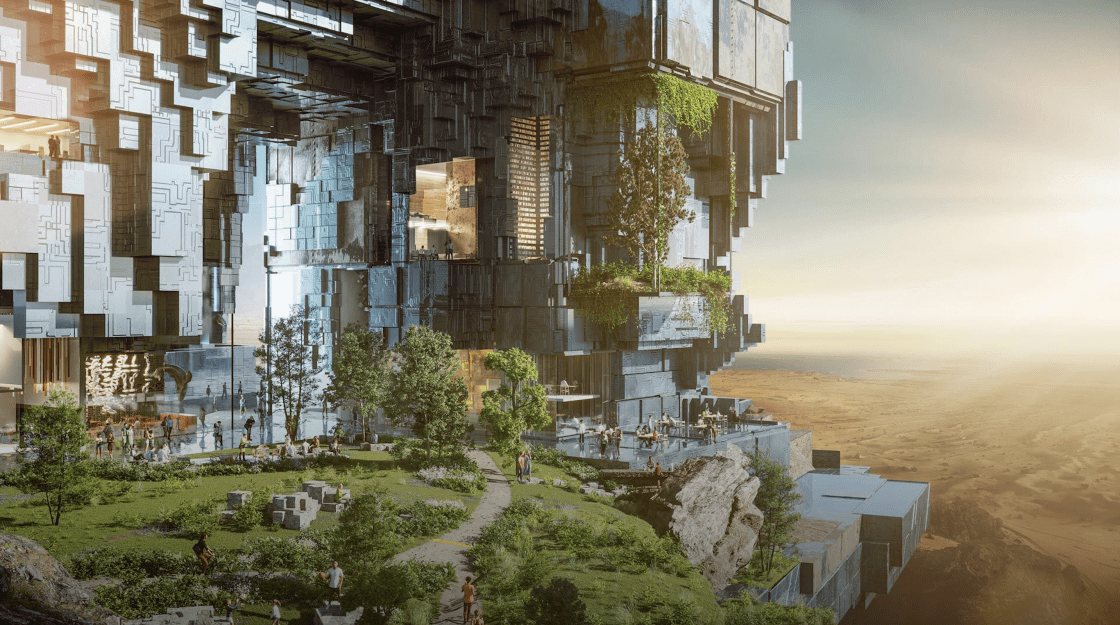Saudi Arabia’s $500 billion megaproject, Neom, and its flagship development, The Line, represent a monumental venture in urban innovation led by Crown Prince Mohammed bin Salman. This revolutionary project aims to set a benchmark for future human civilization by redefining how cities are built, how resources are used, and how people can live sustainably in high-density environments. With an estimated 20% of the world’s steel currently allocated to The Line’s construction, this project is reshaping the architectural and engineering landscape while becoming an unprecedented example of sustainable and smart urban design. Here’s an in-depth look at the technicalities, objectives, and implications of this futuristic development.
The Visionary Architect: Crown Prince Mohammed bin Salman and Saudi Vision 2030
Crown Prince Mohammed bin Salman (MBS) has propelled The Line and Neom forward as part of his ambitious Saudi Vision 2030 plan, designed to transform the Saudi economy and reduce dependence on oil. His approach fuses environmental sustainability with advanced technology, aiming to create a metropolis that embodies his vision of a post-carbon, technologically integrated society. MBS envisions The Line as a living model for future cities worldwide, focusing on livability, ecological conservation, and minimal resource footprint, emphasizing that “we cannot ignore the livability and environmental crises facing our world’s cities.”
What is The Line? An Architectural and Engineering Revolution
The Line is a 170-kilometer-long city, only 200 meters wide and rising 500 meters high, planned to accommodate nine million people. Designed without cars or traditional roads, it integrates a high-speed transit system that can travel the length of the city in 20 minutes. The Line’s exterior facade will feature mirrored glass, allowing it to seamlessly blend into the surrounding desert, mountains, and Red Sea coast, while its internal design is organized into vertical layers. These layers comprise residential, commercial, and recreational spaces accessible within a five-minute walk, redefining urban density and proximity.
The Line will occupy only 34 square kilometers, compared to conventional cities with similar populations that span hundreds of kilometers. This condensed footprint is achieved by using a multi-layered approach to “zero-gravity urbanism,” where verticality is prioritized to make efficient use of space. The absence of cars and traditional road infrastructure is supported by an underground network for logistics, connected to a pedestrian layer above, and a transit layer that lies deep underground for high-speed travel.
The Technical Backbone: 20% of the World’s Steel in a Smart City
The Line’s engineering demands are staggering, with approximately 20% of the world’s steel production allocated to meet its requirements. This level of consumption is unprecedented, rivaling some of the largest infrastructure projects in history. Most of this steel will go into constructing The Line’s towering mirrored facade and reinforced structural elements, designed to withstand harsh desert conditions and provide both insulation and cooling to reduce energy requirements.
To meet sustainability goals, the steel is reinforced, corrosion-resistant, and used in modular components, maximizing its durability and minimizing the need for future maintenance. The project also employs modular and prefabricated construction techniques, which help reduce construction waste, a key component of sustainable urban planning. The reliance on steel in such an unprecedented volume creates a ripple effect across global logistics and materials industries, sparking innovations in supply chain management and forcing increased production capacity for eco-friendly materials.
The Technological Core of Neom and The Line
Artificial Intelligence, Smart Surveillance, and Predictive City Management
The Line will be equipped with advanced artificial intelligence (AI) systems, using predictive analytics to manage everything from energy consumption to daily logistics and security. This AI-driven model allows the city’s systems to respond in real-time to residents’ needs, adjusting climate control, lighting, and even waste management based on predictive data patterns. These AI systems will be embedded throughout the city, integrated into every layer from residential areas to the high-speed transit system, creating a city that “reacts to what we need, not the other way around.”
Data as Currency: Privacy and Surveillance in a Smart City
The Line’s innovative infrastructure includes a complex data network, where residents’ data is essential to the city’s management. Privacy concerns aside, this data acts as a “currency” within the city, feeding AI models that improve service efficiencies and personalize residents’ experiences. This level of data collection extends to sensors throughout public and private spaces, integrated to monitor air quality, water usage, and even personal health metrics. The Line’s digital infrastructure will be governed by strict data laws to ensure resident privacy, balancing security with convenience.
Energy and Environmental Sustainability: Green Power for a Zero-Carbon City
A cornerstone of Neom and The Line’s construction is its commitment to zero-carbon operation. The city will run entirely on renewable energy, incorporating solar, wind, and green hydrogen as primary energy sources. Neom has established Enowa, a subsidiary dedicated to energy and water, which will oversee the development of green hydrogen production and innovative water desalination systems. This renewable energy framework powers the entire infrastructure, from residential buildings to industrial zones, and ensures that The Line’s environmental footprint is minimized.
In terms of water management, Neom’s water system uses zero-waste desalination technology, designed to supply fresh water sustainably to millions of residents in an arid environment. The Line’s layout also allows 95% of the surrounding land to be preserved for nature, ensuring that its environmental impact remains as limited as possible.
Modular, High-Speed, and Vertical: Revolutionary Construction Techniques
The Line’s construction methods are highly modular, employing prefabricated materials to streamline the build process and reduce on-site emissions. Each building section, or “module,” is assembled on a massive scale, with robotic systems assisting in construction to expedite assembly and ensure uniform quality.
One of the most innovative aspects of The Line’s construction is its three-dimensional transport system, which consists of three layers: a pedestrian-friendly surface layer, an underground layer for goods and logistics, and a high-speed transit layer at the deepest level. This transit network enables residents to move through the entire city in just 20 minutes, creating a seamless connection from one end of The Line to the other. In addition, automated electric trains powered by the city’s renewable energy sources reduce emissions and create an entirely sustainable transport ecosystem.
Redefining Livability: From Climate Control to Proximity and Human Interaction
The Line’s internal design and climate control systems are structured to offer a comfortable living environment year-round. The city’s narrow footprint allows for controlled air flows, balancing sunlight, shade, and ventilation to create microclimates tailored to Saudi Arabia’s desert environment. Additionally, The Line offers open spaces and suspended gardens on every level, allowing residents immediate access to green spaces and nature within a high-density structure.
The concept of “proximity” within The Line revolutionizes daily living. In most cities, residents commute to work, shopping, and recreational activities. Here, each resident has access to these needs within a five-minute walk, creating spontaneous social interactions, a greater sense of community, and ample leisure time. The design philosophy supports well-being, allowing residents more time for personal pursuits and reducing the physical and mental strain of commuting.
Technical Overview of Neom and The Line
- Scale: 170 km length, 500 meters high, 200 meters wide; will house 9 million people
- Footprint: Only 34 square kilometers, preserving 95% of surrounding nature
- Steel Consumption: Utilizes 20% of global steel production, incorporating corrosion-resistant, high-durability steel in a modular construction framework
- Design: A linear city without cars or roads, using vertical and layered zoning for residential, commercial, and recreational spaces
- Transit: Multi-layered transport system, including a high-speed rail network covering the entire city in 20 minutes
- Renewable Energy: Powered by solar, wind, and green hydrogen produced by Enowa, Neom’s energy and water subsidiary
- Data Integration: AI-driven city management; data collection from sensors to optimize resource use, security, and resident services
- Water Management: Zero-waste desalination, eco-conscious water supply system for desert sustainability
- Climate Control: Built-in microclimate systems using controlled airflow, natural ventilation, and green spaces to maintain comfort
A Blueprint for the Future of Civilization
Neom’s The Line serves as a prototype for urban living that balances the demands of modern society with ecological sustainability, dense population management, and advanced technology. By condensing a large population within a narrow, vertical space, The Line mitigates the sprawling infrastructure that contributes to carbon emissions and resource depletion in traditional cities. It provides a model of self-sufficiency, relying on renewable energy sources, cutting-edge AI, and strict data management to operate seamlessly.
With its 20% share of the world’s steel production, modular construction, and reliance on renewable energy, The Line sets a new standard for ambitious urban development. Its influence will likely reshape how future cities are conceived, pushing the boundaries of architectural design, sustainability, and integrated living spaces.
The Dawn of a New Urban Era
As The Line nears completion of its initial segments, it is already redefining global perspectives on what a city can be. Saudi Arabia’s Neom and The Line stand as testament to what can be achieved when technological innovation, sustainability, and visionary leadership come together. Through this project, Crown Prince Mohammed bin Salman is carving a new path for human civilization, where cities not only sustain their residents but also contribute actively to a healthier planet. Neom and The Line hold a unique place in history, setting the stage for future urban developments and creating an era where sustainability, livability, and technology are harmoniously intertwined.
Reads About The Line at Neom
Neom Website
Neom Wikipedia Overview
The Line Website
The Line Wikipedia Overview


